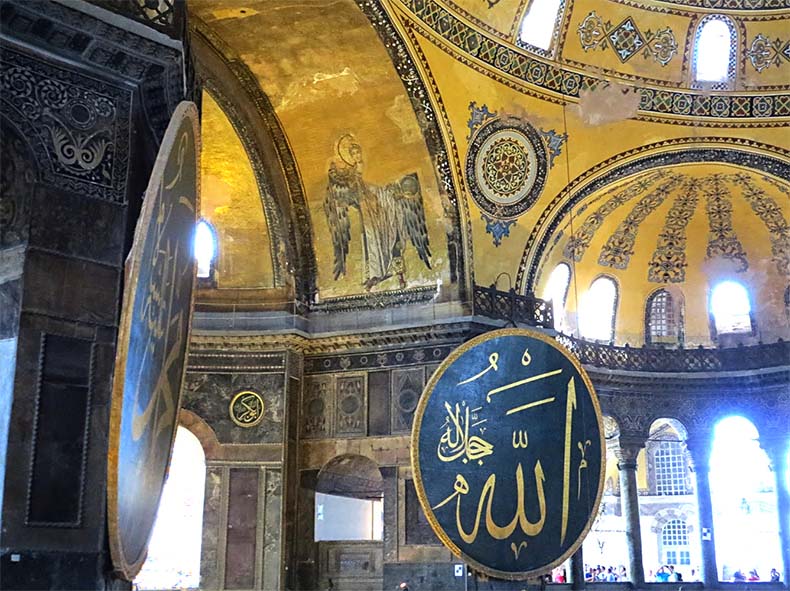 The mosaics of the two archangels were huge - each one is around 30 feet tall - you can check out the image below from the 1930's for the scale. It is a great shame that we have lost almost all of Michael, but what we have of Gabriel is enough for us to understand the intention of the artists who made them in the 9th century. Thy were planned and designed by the clergy of Hagia Sophia, were ordered by the Patriarch and probably executed by church artists. This was after the end of iconoclasm, a period when religious images had been banned and destroyed by Byzantine emperors. There mosaics did not go up immediately after images had been restored, a few years were allowed to pass before they were ordered. There were two locations where the most important icons were raised up again one was Hagia Sophia and the other was the Chalke Gate of the Imperial Palace. There were two problems the church faced in redecorating Hagia Sophia with mosaic images; one nothing of that scale had been attempted in generations and two, there was a lack of experience artists and supplies. Millions of mosaic cubes were needed and the only immediate source was recycling old tesserae from older buildings. Many of these tesserae were damaged in salvaging them, getting chipped corners. Eventually Byzantium would be making tons of new mosaic, but that would be years after our mosaic was made. The only available mosaic artists had been making panels of mythology, charioteers, and secular scenes glorifying the emperor and his family. We don't know how far the visual arts had decayed by this time because almost nothing survives. Religious art still was being created, but on a small and secret scale,. The penalty for painting an icon was hand amputation, even death. Monumental religious art had been extinguished in the Byzantine Empire. Bringing it back from the dead would truly be a resurrection. Learning how to make big mosaics like these was a bit hit-or-miss. The artists learned project-by-project and established new traditions and methods that evolved into recognized workshops, which reached its zenith in the 12th century Deesis mosaic of Christ almost 300 years later.
The mosaics of the two archangels were huge - each one is around 30 feet tall - you can check out the image below from the 1930's for the scale. It is a great shame that we have lost almost all of Michael, but what we have of Gabriel is enough for us to understand the intention of the artists who made them in the 9th century. Thy were planned and designed by the clergy of Hagia Sophia, were ordered by the Patriarch and probably executed by church artists. This was after the end of iconoclasm, a period when religious images had been banned and destroyed by Byzantine emperors. There mosaics did not go up immediately after images had been restored, a few years were allowed to pass before they were ordered. There were two locations where the most important icons were raised up again one was Hagia Sophia and the other was the Chalke Gate of the Imperial Palace. There were two problems the church faced in redecorating Hagia Sophia with mosaic images; one nothing of that scale had been attempted in generations and two, there was a lack of experience artists and supplies. Millions of mosaic cubes were needed and the only immediate source was recycling old tesserae from older buildings. Many of these tesserae were damaged in salvaging them, getting chipped corners. Eventually Byzantium would be making tons of new mosaic, but that would be years after our mosaic was made. The only available mosaic artists had been making panels of mythology, charioteers, and secular scenes glorifying the emperor and his family. We don't know how far the visual arts had decayed by this time because almost nothing survives. Religious art still was being created, but on a small and secret scale,. The penalty for painting an icon was hand amputation, even death. Monumental religious art had been extinguished in the Byzantine Empire. Bringing it back from the dead would truly be a resurrection. Learning how to make big mosaics like these was a bit hit-or-miss. The artists learned project-by-project and established new traditions and methods that evolved into recognized workshops, which reached its zenith in the 12th century Deesis mosaic of Christ almost 300 years later.
Hagia Sophia today is missing all of its sanctuary furnishings, including the ciborium and great altar, the chancel screen, solea and ambo - which was near the center of the church. There were also steps in the apse where the clergy set, surrounding a throne for the patriarch. The purpose and reason for the existence of the church was the worship of God and the celebration of the Eucharist. For the common people it was also a place of assembly for great events and the site of Imperial ceremonies, like the coronation. When rumors spread of military defeats or revolution the people would move from the forum and public colonnades into the church to get the latest news. People took refuge there when they were being chased by the police for crimes. If you were able to grab hold of the Holy Gates of the Cancel Screen - or even the altar - you were safe - at least for a while. Getting your hands on the altar meant you had reached the "Holy of Holies", but that required getting through those Holy Gates and into the very sanctuary. You would think that the sanctuary would have been under guard all the time, but it wasn't. People were able to claim refuge all the time. Sometimes these asylum seekers were chased into the church - other people made there way in through other ways. In back of the apse were two chapels, one of Saint Nicholas and the Other of the Holy Well. These chapels could be accessed from the back of the church. They had gate-keepers there. The Chapel of Saint Nicholas as considered part of the sanctuary - if you got in there you were probably safe. During the civil conflict that brought Alexis I Comnenus to the throne the women of his family fled to the Chapel of Saint Nicholas for protection. The warder admitted them when he was told they were ladies from the east who were making a last stop to pray in Hagia Sophia on their way back home.
Once you grabbed the altar the police would try to pry you loose, arrest you and get you out of Hagia Sophia before you were noticed by the public. During the hours it was open Hagia Sophia was one of the most public places in the city. If you were a fugitive you wanted people to see you had made it to the altar so they could plead with the police to leave you alone. The next step for a fugitive was to wait for the clergy to arrive. Before you turned yourself over to them you would have demanded the authorities swear on the cross that you were safe. It was important to use the biggest cross you could find so that the maximum number of people witnessed it.
These appeals for refuge were treated very seriously by the church. The Patriarch's palace was attached to the south side of Hagia Sophia and news of refuge seekers reached him fast. There was a cause where a patriarch intervened with the police to protect one asylum seeker who was afraid to let go of the altar for fear the police would drag him off. The patriarch promised the fugitive he would accompany him to meals and also to use the latrines attached to Hagia Sophia. Indeed, he came across from his palace via the South Gallery into the nave to check on him several times a day. The man in question was accused of a civil crime and ended up being acquitted. I'll bet the attention the patriarch had given to him made a difference.
In the apse we have four figures the Virgin holding the Christ Child in her lap and the two archangels, Gabriel and Michael, one on either side. When the altar was in place the Christ Child was over it, it was like he was offered as a sacrifice for the salvation of mankind. The two angels acted as members of a celestial court of honor for Christ and his mother. That is why they are dressed in the silken robes of a courtier and hold staffs. These two figures are very colorful, using lots of rare glass mosaic in place of dull stone in places like the face, which is very lively with rosy coloring in the cheeks. The blond hair is haloed in rows of gray stone, something I have never seen anywhere else. Great care was given to the exotic coloring of the wings and the modeling of the white chlamys cloak, which was part of the official uniform for court officials in the 9th century. Modeling figures this large was a great challenge to the artists who, in this period, had fewer shades of colors of mosaic to work with. The fingers are roughly drawn because they have to be seen at a great distance,
Like members of the Imperial court they stand on either side of the throne to adore and protect Christ. Images of angels, specifically the orders of Cherubim and Seraphim, were required by God to decorate the Temple in Jerusalem. They were the only heavenly entities that were permitted. They were carved, gilded and painted. The Bible tells us that that there are a number of orders of angels and their primarily responsibility is to worship God. Hagia Sophia was filled with hundreds of images of them, yet only 5 survive, two of those only in fragments.
Our angels were not easy to see from the nave of the church and would have been most visible to the clergy in the sanctuary and people in the galleries. The best view was from the farthest passageway overlooking the apse in the eastern end. Gabriel is been best seen from the North Gallery. In the South Gallery the Imperial chapel was at the far eastern end. Emperors and their families watched the liturgy from there and the vanished Michael would have been on the opposite side of the apse. The survival of Gabriel mosaic helps us understand how these archangels were part of the divine court of heaven.
We can imagine that these two archangels were modeled on illustrations from a manuscript and have been blown up somehow to an enormous size. Were they drawn freehand on the plaster? They must have been approved in advance because the scaffolding would have been in the way. Any corrections from the ground while the mosaic was being made would have been almost impossible to make. I think the figures of the Angels, the Theotokos and Christ were drawn in paint, the scaffold was partially dismantled so you could see the mock-up. The scaffolding was raised again and the mosaic work was underway.
One should also remember that they were never meant to be seen with spotlights like they are today. The figures would have been seen in shadowed natural light during the day. During nighttime services and all night vigils they would have been illuminated by twinkling glass lamps, whose lights would have appeared like stars at their feet. Add a choir and the scent of fragrant incense and scented oils in the lamps - the effect at night must have been overwhelming. One additional aspect that is now missing is how the figures were set in the vast, glittering plain gold mosaic of the vaults. You would really have felt you were in heaven with the angels.
Perhaps Gabriel's face appears more feminine to us today, but a Byzantine viewer would have seen him as a beautiful ageless youth. The face has also been weakened by the fact the pupils of the eyes have been hacked out by someone who intentionally vandalized the mosaic sometime in the past. We should remember that angels are not human and only appear to us in our form so we can interact with them on Earth. In reality they are manifestations of the pure power of God that has been tempered and filtered though their appearance in human form. Angels cannot be worshiped, any veneration of them passes to God alone. In contrast to Gabriel, Michael would have had dark hair and different colored clothes. There was a shrine to the archangel Michael on his side of the church in the South Gallery, near one of the great piers of the church. The story was told that Michael protected the church from this location and that he had appeared there during the construction of Hagia Sophia.
On either side of both archangels are bands of garlands of flowers. These encircle the apse and its windows, On special feast days and for the reception of foreign guests, the church was decorated with huge garlands like these. Also, the crazy painted stencils and borders date from 1850. The vaults and semi-domes were originally plain gold mosaic. The huge round Islamic discs with their beautiful calligraphy also date from 1850. They replaced earlier ones that were smaller and fit the architecture much better.
Bob Atchison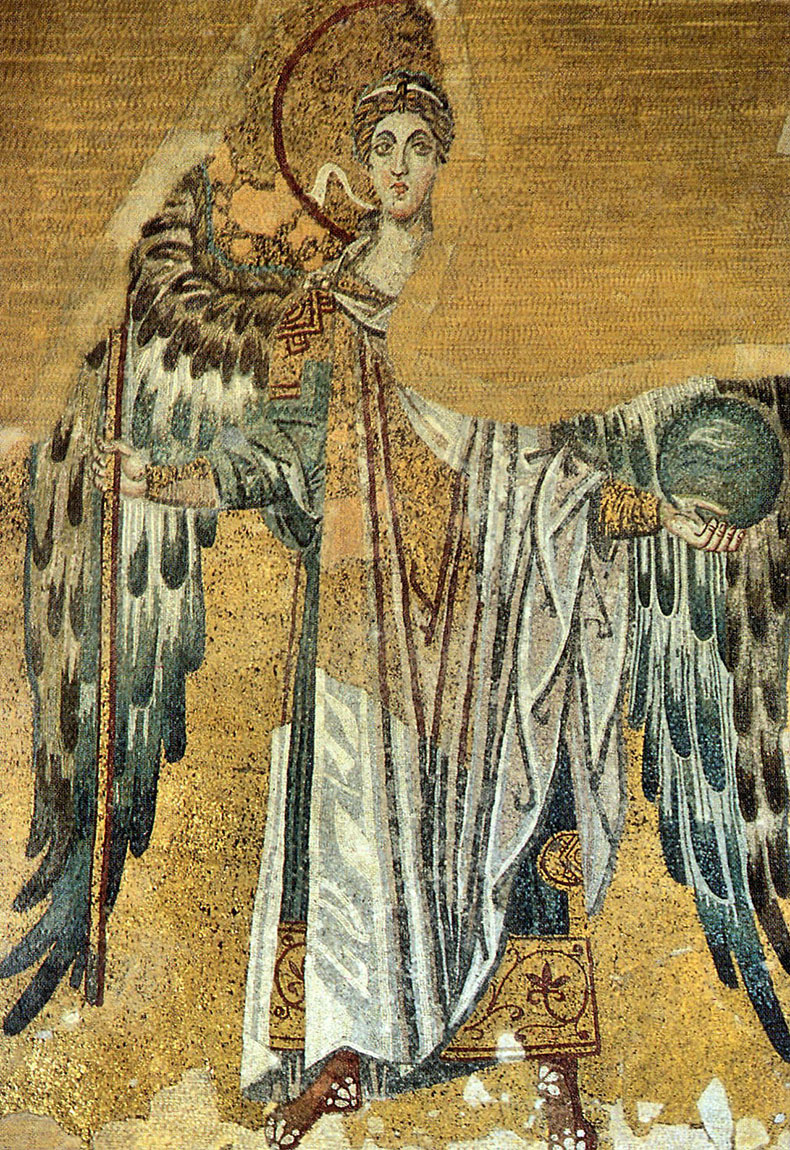
The descriptive text below is from The Apse Mosaics of St. Sophia at Istanbul. Report on Work Carried out in 1964 - Cyril Mango and Ernest J. W. Hawkins
THE SOUTH ARCHANGEL
For the sake of convenience we shall refer to this archangel as Gabriel, in accordance with the Byzantine custom of depicting Gabriel on the left hand and Michael on the right hand of the Virgin in the apse of a church. Gabriel, clad in red buskins, tunic, and chlamys, is represented standing frontally, holding a staff in his right hand and a crystal globe in his left The left shoulder, a little less than half of the halo, the upper part of both wings, and the top of the staff have been destroyed. Originally, the staff may have formed part of a labarum inscribed with the trisagion, as was the case in the Dormition Church at Nicaea.
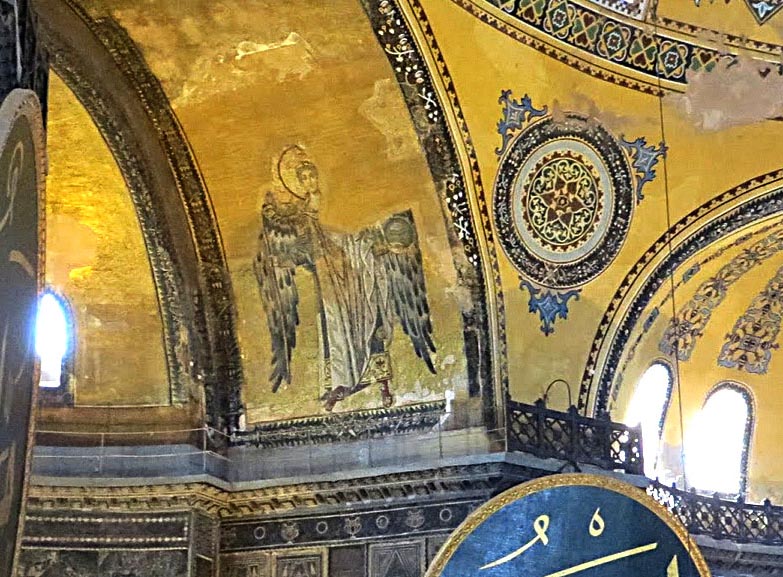

The Halo
The halo is outlined with four rows of red glass tesserae. The field of the halo is gold, set concentrically, with a very slight admixture of silver cubes.
The Head and Neck
The archangel's abundant hair is gathered round the head in thick plaits and falls down the back of the neck, showing over the right collarbone. The lighter strands are in yellow glass at the top and on the right of the figure, and in yellow-green glass on the left. The darker strands are in olive, mat brown, and clear brown glass, and there are a few lines of black glass. High lights are provided by occasional lines of gold tesserae. Over the middle of the forehead the hair is arranged in a flower-like form. The contour of the hair is outlined against the gold of the halo by one or two rows of pale turquoise glass. The hair is tied with a ribbon of white marble tesserae, its ends (only one end is preserved) fluttering behind the head.
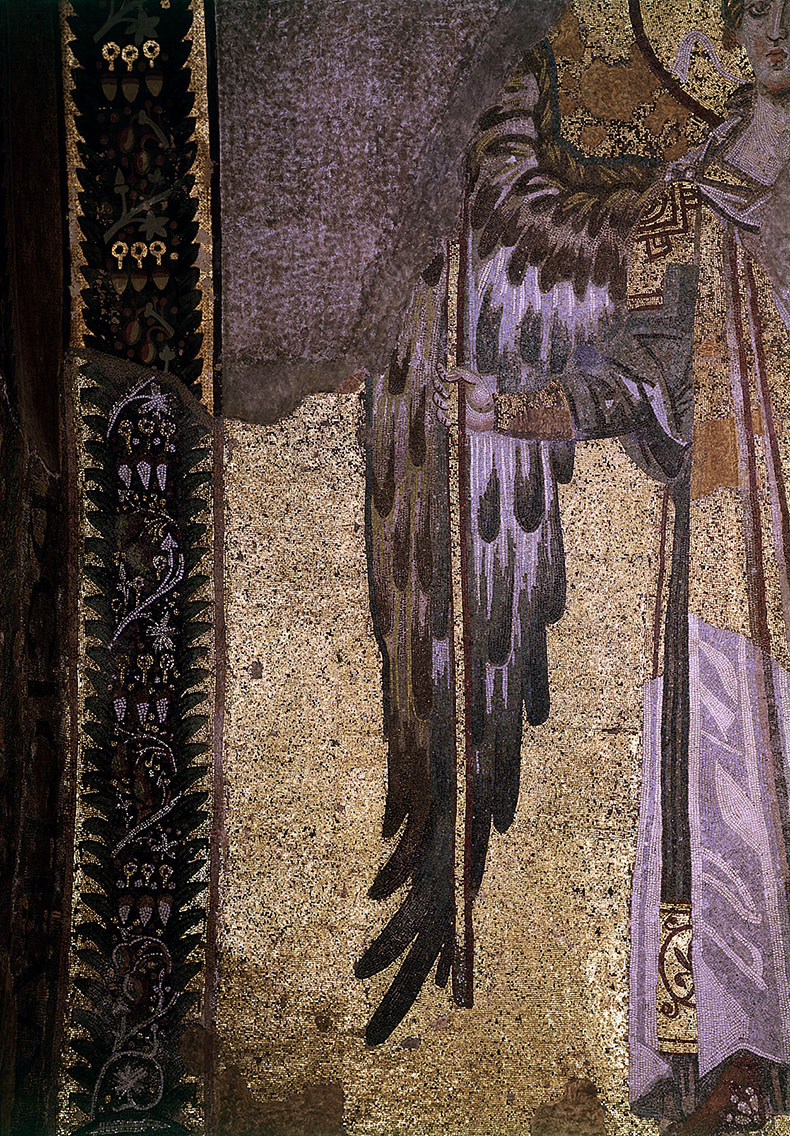
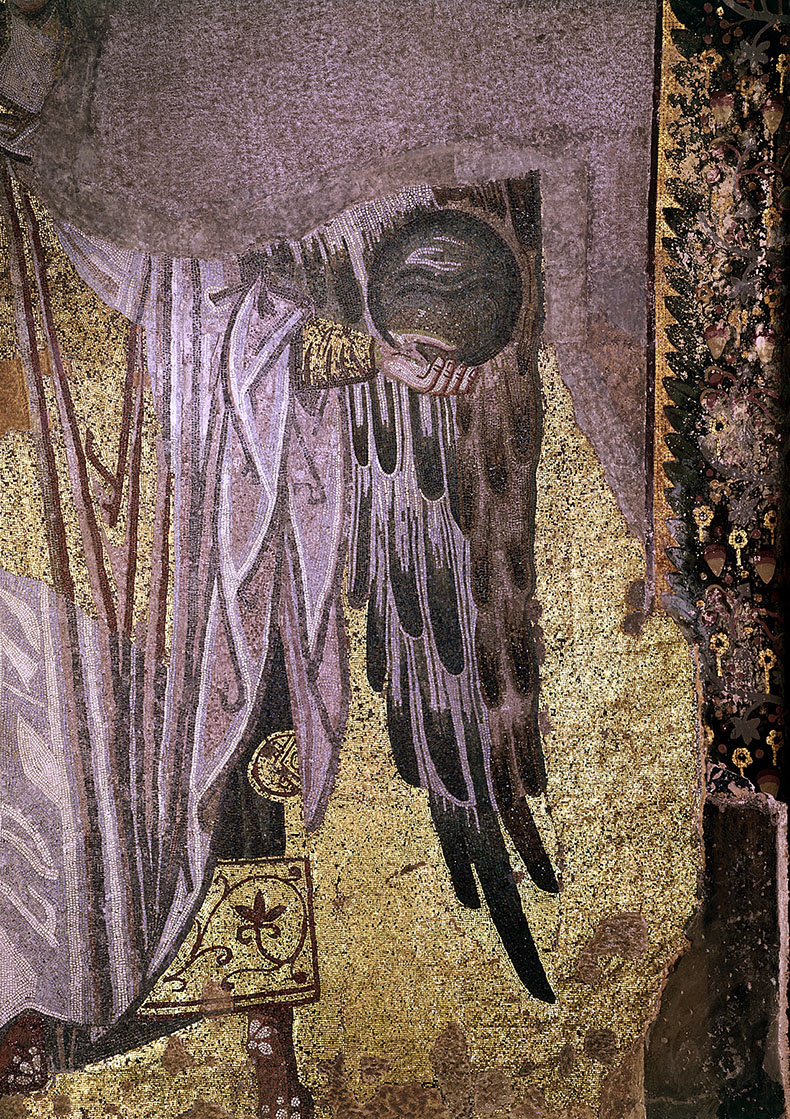
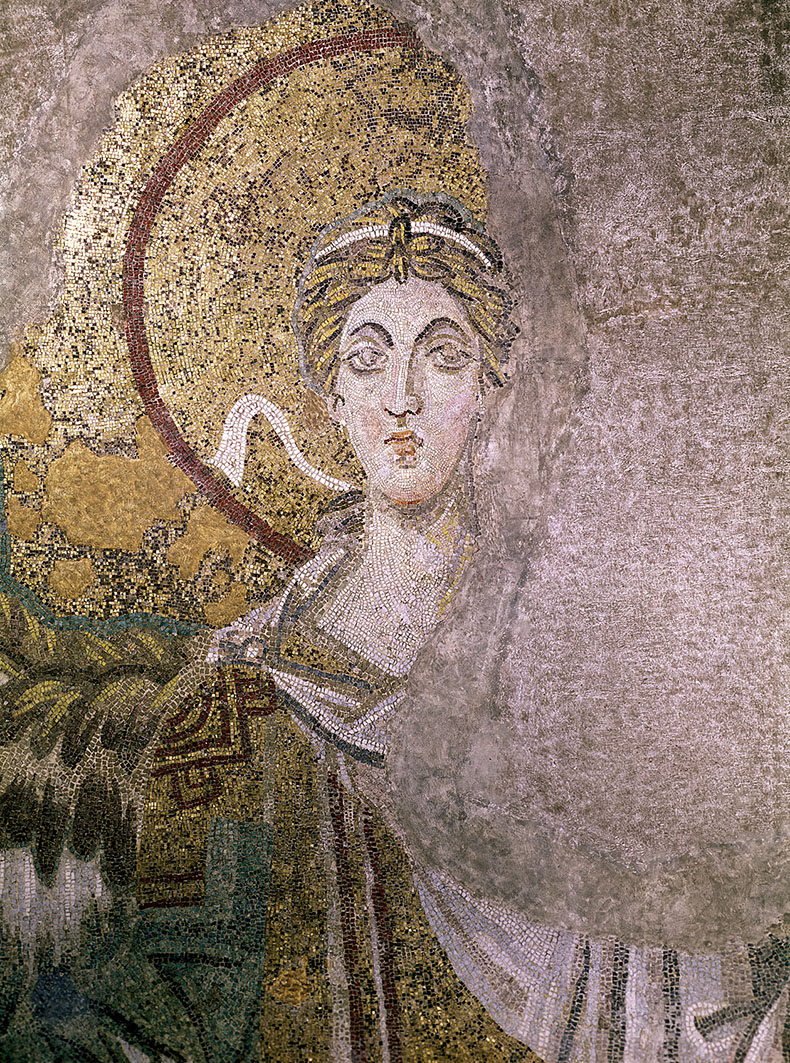
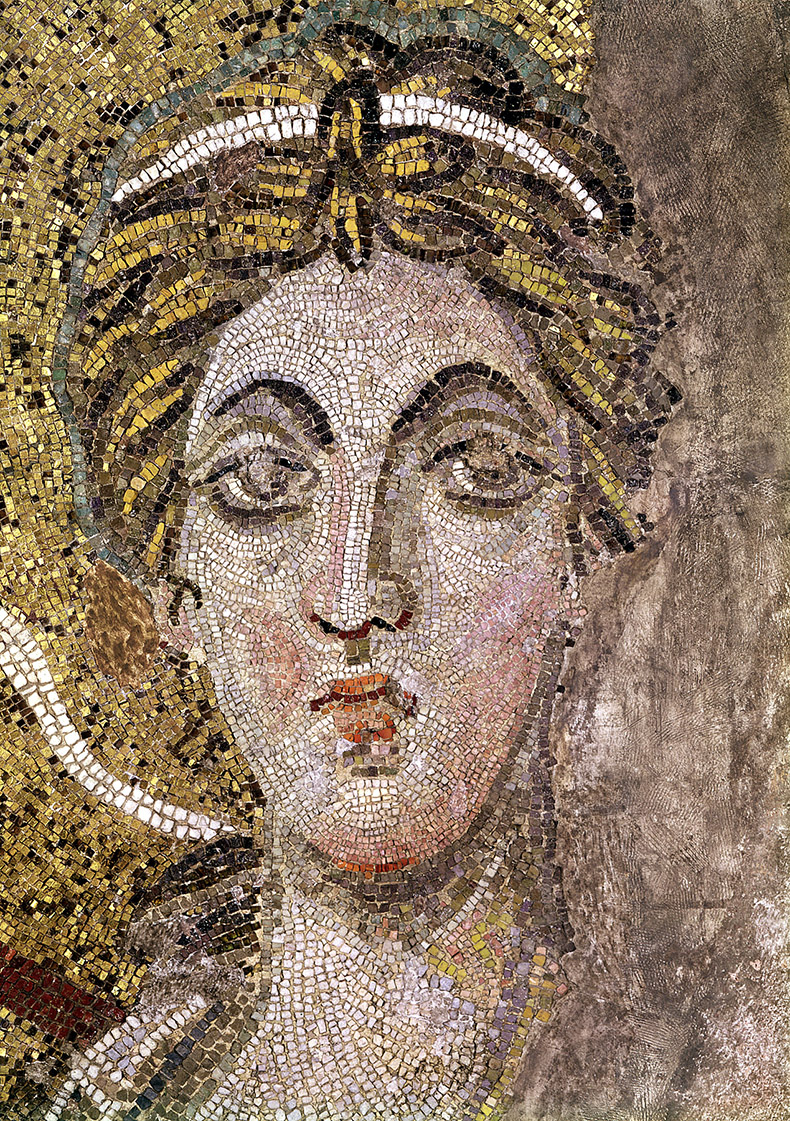
The eyebrows, markedly arched, are in mat brown glass, the upper eyelids in black and mat brown glass, the lower eyelids in mat brown glass with a line of olive shadow underneath. The pupils of both eyes have been gouged out. The whites of the eyes have high lights in white limestone, the rest being in off-white milky glass.
The flesh tones used in the face and neck are fine-grained white marble, Proconnesian white marble, Proconnesian grey, cream marble (used very sparingly), and two or three tones of pink marble. Extensive use is made, furthermore, of off-white milky glass which has sometimes a bluish, sometimes a purplish tinge; this forms the right outline of the face, the left outline of the forehead, the pockets under the eyes, the area of light shadow to the left of the nose, etc. Olive glass is used for strong shadows to the left of the nose, round the eyes, the dimple under the nose, and for the shadow under the mouth, where it is mixed with lighter shades of glass and with pink marble. The tip of the nose and parting of the mouth are in deep red glass. Vermilion glass is used in the lips (in the lower lip it is mixed with pink marble) and one line of it forms the end of the chin. The nostrils are in black glass. No green or yellow-green occurs in the archangel's face.
The shadow under the chin is in olive and purple-brown glass. On the left side of the neck an effect like that of a cast shadow is obtained by a mixture of pink marble and yellow-green glass. This is the only part of the mosaic which may be called impressionistic; elsewhere the modelling, though relatively free, is nevertheless linear. The left collarbone is indicated by a shadow of yellow-green glass.
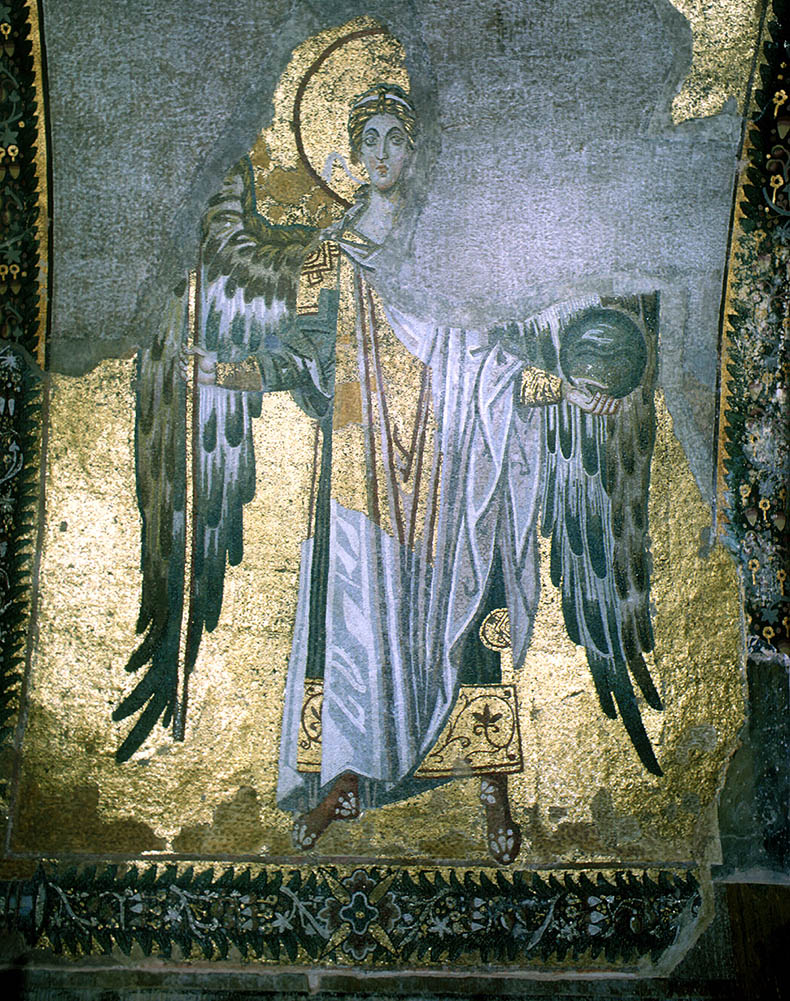
The Right Hand
The upper line of the thumb and fingers as well as the lower line of the thumb muscle are in yellow-green glass. The lower line of the thumb and fingers is in mat brown glass. Each finger has two wrinkles on the second joint in red glass. There are two odd, red glass cubes and one vermilion cube on the muscle of the thumb. The nails, not outlined, are in white Proconnesian marble. The flesh tones are in white Proconnesian marble, cream marble, and two tones of pink marble.
The Left Hand
The shadow on the wrist, the upper line of the thumb (in two rows) and the lower outline of the hand are in yellow-green glass. The fingers and fingernails are outlined in deep red glass which also forms one wrinkle line below each nail. The lower line of the thumb and the iupperline of the palm are in mat brown glass. The flesh tones are in white Proconnesian marble, cream marble, three tones of pink marble, and purple-grey granite. Apart from the heavy green outline, the flesh tones of the thumb (which is meant to be seen through the crystal of the globe) are the same as those of the rest of the hand.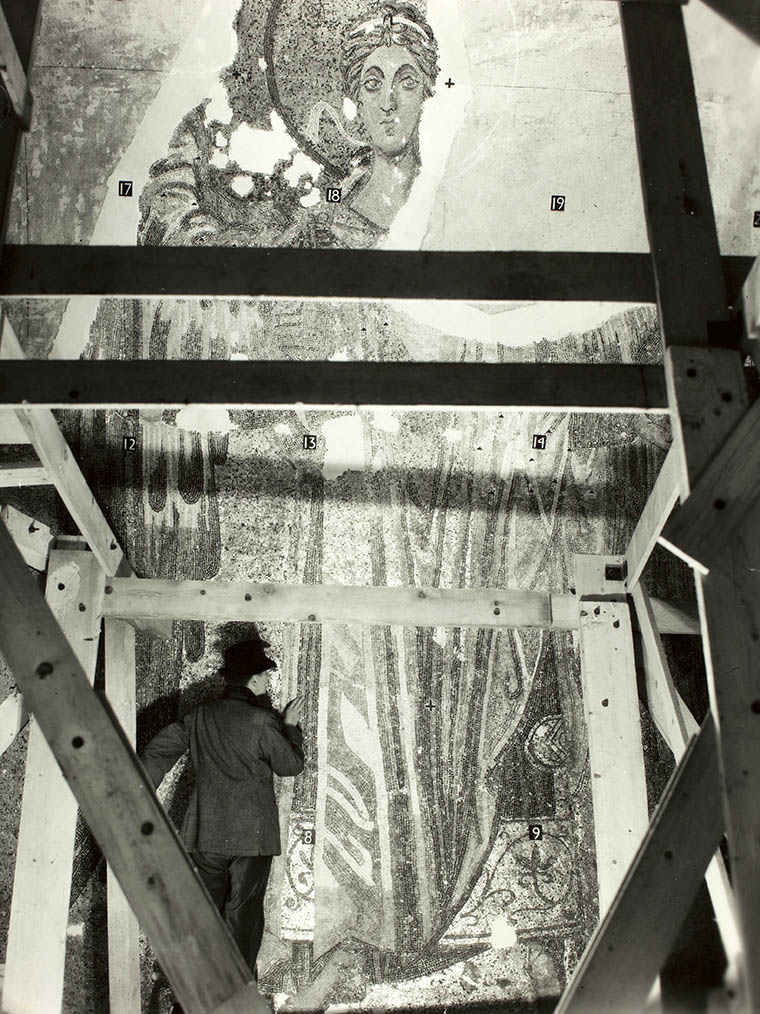
The Feet
The feet are shod in buskins, ornamented both on the heel and the toe with clusters of round and almond-shaped pearls done in white limestone. The buskins themselves are in two tones: the shaded parts are in deep red glass, the lighted parts in terracotta tesserae that were dipped in red lead paint. Either simultaneously with the making of the mosaic, or, more probably, at a later date, the terracotta cubes were further touched up with red paint which covers the interstices between them and is smeared over some of the red glass cubes. The toe of the left foot impinges on the trim of the garland border.
The Wings
The wings are outlined along the top and about two-thirds down the sides with two or three rows of turquoise glass. The general color scheme of the wings is the following: the upper and outer portions are in brown tones, the inner portion is in white, grey, and green tones. The bottom feathers are dark blue and black. The stone tesserae used in the wings are cut big, as they are also in the garments.
The inner (lighter) part of the wings is in grey Proconnesian marble lit with vertical rows of white Proconnesian marble. The tips of the feathers are here in turquoise glass shading off to light turquoise. The surface of the turquoise cubes has deteriorated.
In the outer (darker) part of the wings the following materials are used: yellow-green glass, purple-grey granite, khaki-brown granite, clear brown and mat brown glass (the two latter in the tips of the feathers). The granite has in many places worn off, forming grooves in the surface of the mosaic.
The long, bottom feathers are in blue glass mixed with black glass.
The treatment of both wings is identical, except that the left wing has patches of black glass filling the ends of the brown feathers in the darker outer area, thus producing a more shaded effect.
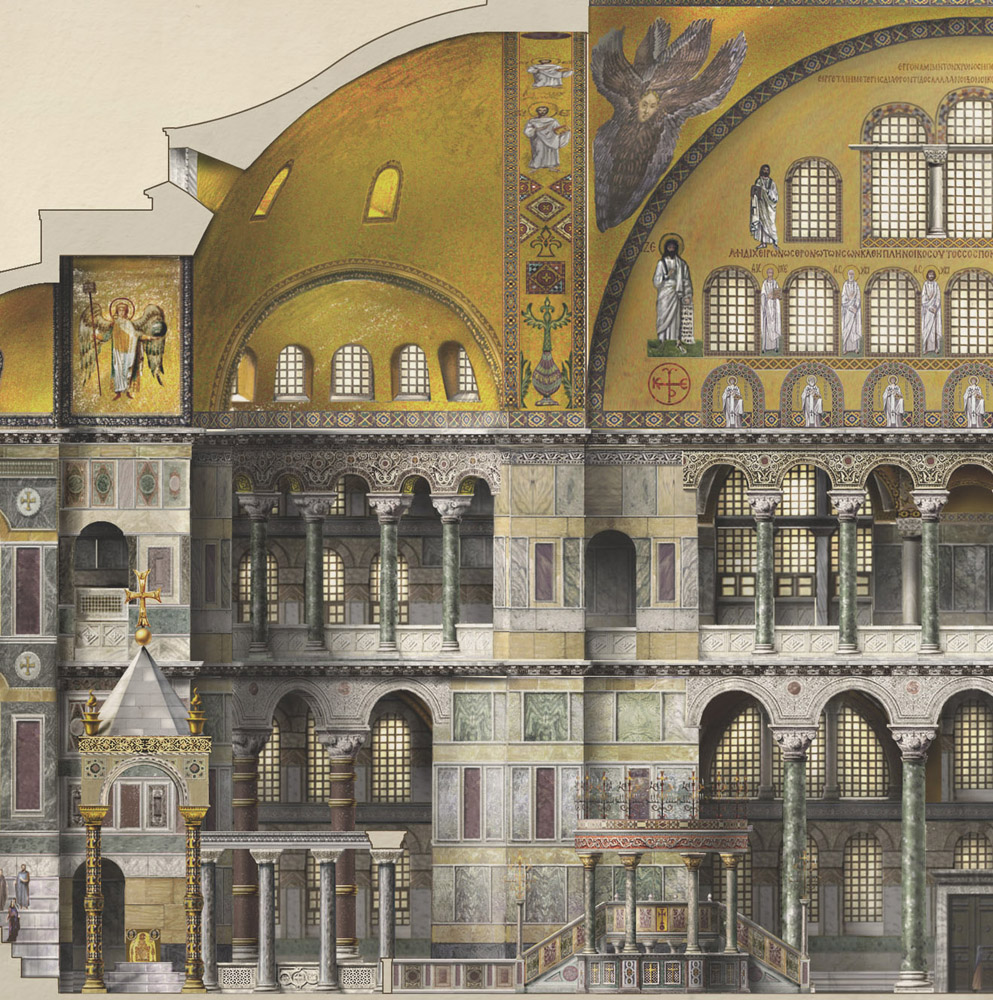 The Tunic
The Tunic
The archangel's lower garment is a beltless tunic (divitision),16presumably made of silk. It is to be seen in the sleeves, in the narrow slit near the left edge where the chlamys is open, and at the lower right. The sleeves are tight-fitting over the wrist and forearm, but expand to a considerable width over the elbow. Sewn on to the tunic are a number of elements decorated with gold thread and embroidery, viz. the collar, hem, and cuffs.
Except for the high lights on the folds of the right sleeve, which are made of grey Proconnesian marble, the entire tunic is in glass tesserae. The dominant color is light turquoise; the shadows and fold lines are in turquoise, cobalt blue, and dark blue. The cuffs are plain gold with fold lines in mat brown glass. The lower outline of the left cuff, three rows wide, is in clear brown glass.
The gold collar is largely hidden by the chlamys, except for the patch over the right shoulder. This is decorated with a diamond design, only half of which shows, containing two concentric circles and a little square attached to each side. The design as well as a double border at the bottom of the patch are in two rows of red glass.
The hem of the tunic is gold decorated with a rinceau in red glass. Within each convolution of the rinceau is a triple leaf with two tendrils curving down- ward. The falling fold of the chlamys divides the hem into two unequal parts, and these parts do not completely match. The smaller section on the angel's right is 0.59 m. high; the section on the left is 0.565 m. high. Furthermore, the upper and lower edging of the hem are different in the two sections: on the right, the upper edging consists of two lines of red glass separated by a band of gold three rows wide, the lower edging of two lines of red separated by five rows of gold. The left section has no red in the upper edging, but, instead, one row of mat brown glass and above it one row of gold; the bottom edging has two lines of red separated by three rows of gold. On the angel's left the tunic is meant to have a lateral slit at the bottom. This slit is edged with a gold stripe terminating in a circular segmentum (diameter 0.27 m.) of which only one half is visible. The segmentum,like the shoulder patch, is decorated with a diamond containing a circle. To each side of the diamond is attached a little square. This design is in single rows of red glass

The Chlamys
The chlamys, which is ankle-long, is decorated with two gold tablia and is clasped with a fibula over the right shoulder. The left tablion covers the breast, while the right one is hidden behind the figure except for a narrow strip that appears beneath the right elbow.
The tablia are gold with a slight admixture of silver cubes, while the rest of the chlamys is done entirely in local stones cut into rather large tesserae (up to i cm. square), namely, white Proconnesian marble for the high lights, grey Proconnesian marble, two kinds of decayed granite, one purple-grey, the other khaki-brown, and finally a slate-grey stone with a thin white vein (known locally as Beykoz stone, after the village of Beykoz on the Asiatic shore of the Bosphorus). Fold lines usually change color when they go across the tablia: grey stone becomes red glass; purple-grey in one place turns to khaki-brown, while in others it does not change color. Both kinds of granite have been eroded, forming grooves in the surface of the mosaic. The fibula is outlined in Beykoz stone. Its center is in white marble.
The Staff
This consists of five vertical rows of gold outlined on the angel's right with one row of red glass and three on the left. The lower tip of the staff (to a height of 0.29 m. from the bottom) was originally silver, but the heads of the cubes have largely disappeared exposing clear glass of a pale honey or greenish color.
The Orb
The orb which the archangel holds in his left hand is outlined, starting from the outside, with two rows of dark blue glass and three rows of turquoise glass. Two wavy lines running across the middle of the globe are each in three rows of turquoise glass. All the turquoise glass has surface patina due to deterioration. The high lights in the upper half of the orb are in white Proconnesian marble. Immediately above the thumb is an elongated patch which appears to have been originally silver. All but a few of the silver heads have, however, fallen off, exposing clear glass of a pale greenish color. The rest of the orb is mostly in pale turquoise glass.
THE NORTH ARCHANGEL
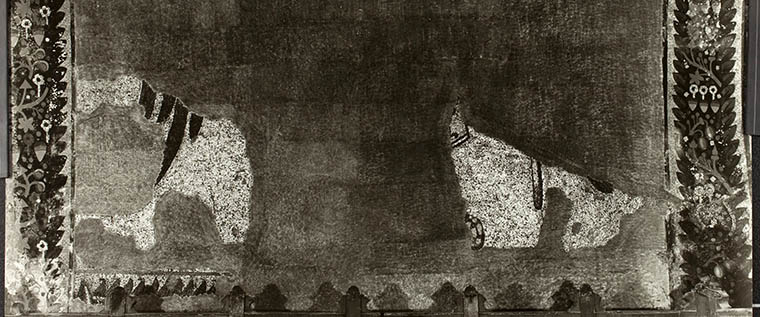 Only tiny portions of this archangel remain, namely: four feathers of the right wing, part of the left foot, part of the ornamented hem of the tunic, the tip of the staff, the tip of one feather of the left wing, and, much higher up the arch, an insignificant fragment of the halo. The execution of these fragments is in all respects similar to that of the Archangel Gabriel. The buskin is in two shades of red, the lighted parts being in terracotta, the darker parts in red glass. The pearls on the toe of the buskin are in white limestone. The staff was in five vertical rows of gold, outlined with one row of red glass on the angel's right and three on the left. The tip of the staff, to a height of O.I9 m., was in silver, but the heads of most of the silver tesserae have flaked off, exposing clear glass. The feathers are in clear brown, pale turquoise, turquoise, dark blue, and black glass. The hem of the tunic is gold with a double, red line at the bottom and traces of a rinceau pattern, also in red.
Only tiny portions of this archangel remain, namely: four feathers of the right wing, part of the left foot, part of the ornamented hem of the tunic, the tip of the staff, the tip of one feather of the left wing, and, much higher up the arch, an insignificant fragment of the halo. The execution of these fragments is in all respects similar to that of the Archangel Gabriel. The buskin is in two shades of red, the lighted parts being in terracotta, the darker parts in red glass. The pearls on the toe of the buskin are in white limestone. The staff was in five vertical rows of gold, outlined with one row of red glass on the angel's right and three on the left. The tip of the staff, to a height of O.I9 m., was in silver, but the heads of most of the silver tesserae have flaked off, exposing clear glass. The feathers are in clear brown, pale turquoise, turquoise, dark blue, and black glass. The hem of the tunic is gold with a double, red line at the bottom and traces of a rinceau pattern, also in red.

The following is from a great article on Angels from "A Reader's Guide to Orthodox Icons":
"The fiery ministers of God described above are common enough in Orthodox hymnography and iconography and their form is well-known, yet their appearance is not that which immediately comes to mind when we hear the word angel. We tend to think first of a winged-man, and this form comes from what has been revealed to us regarding the Angels and Archangels.
Although all the bodiless powers are known as angels (because they are all messengers), the name is specifically given to the “ministering spirits” at the bottom of the celestial hierarchy, i.e. those closest to Man. These angels appear throughout Scripture – indeed throughout history – to people, to bring messages from God, to guide us, and even to protect us. With so many recorded manifestations, a general appearance of an angel is formed: a youthful man, often with a light-bearing countenance, frequently wearing white robes.
St John Damascene says that the angels “do not appear exactly as they are to the just and to them that God wills them to appear to. On the contrary, they appear under such a different form as can be seen by those who behold them” (Exact Exposition).
Therefore we can say that the revealed image of the angel, like the name, tells us more about their role than their nature. As Dionysius writes, they are depicted “under the likeness of men, on account of the intellectual faculty, and their having powers of looking upwards, and their straight and erect form..” and “the figures of manhood and youth denote the perpetual bloom and vigour of life”. And so, whilst angels themselves are not divided into “male” and “female”, they always appear in Scripture and in Icons as young (beardless) men. Statues and images of angels as young women with wings appear only much later in churches, and are not based in Christian tradition.
“The shining and glowing raiment”, continues Dionysius, “signifies the Divine likeness after the image of fire, and their enlightening, in consequence of their repose in Heaven, where is the Light, and their complete illuminating intelligibly, and their being illuminated intellectually.”
In all the divine revelations of angels as young men, they are never described as having wings. Indeed, the earliest depictions of angels in the first centuries of the Church show them as wingless young men in white robes. Nevertheless, it is now common to show angels with wings. The wings can be understood in the same way as halos. Halos on Christ and the Saints (and also on angels) are not photo-realistic, but symbolize the holiness of the subject, a holiness which is undeniably real. The wings of the angel symbolizes swiftness and “the lightness of the wings denotes their being in no respect earthly, but undefiled and lightly raised to the sublime” (St Dionysius, The Celestial Hierarchy). The wings also indicate the relationship of these beings with the Heavenly ranks of the Seraphim and Cherubim, which in Divine revelation are indeed shown with wings."
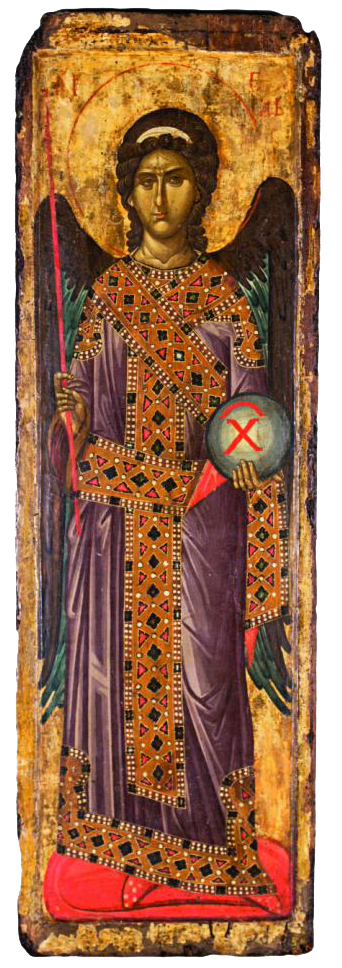
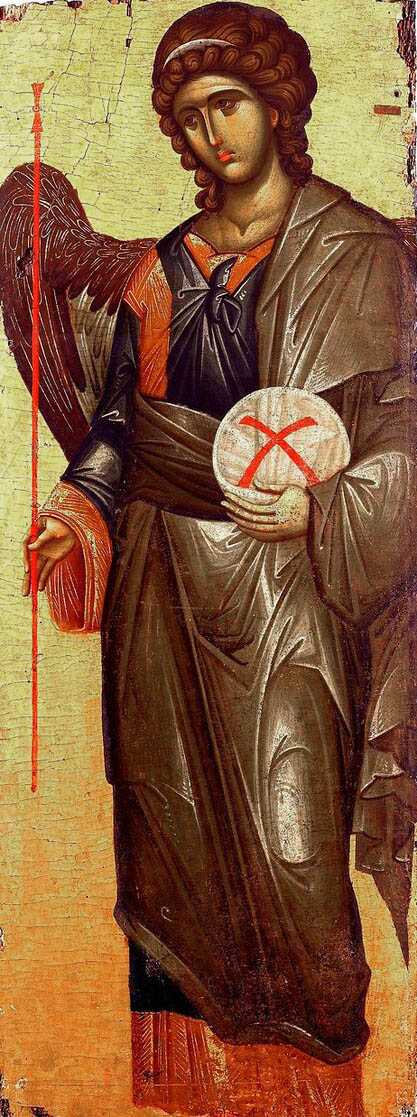
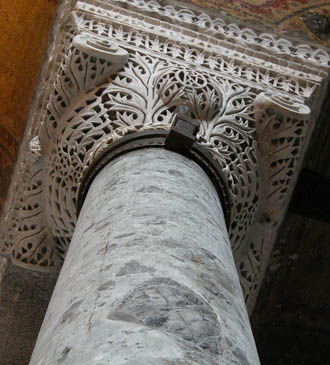 The capitals have monogram of the Emperor Justinian on them. We know the capitals were painted blue and gilded in the reign of the Emperor Romanos. Paint still remains in the deepest parts of the carving on some or all of the capitals.
The capitals have monogram of the Emperor Justinian on them. We know the capitals were painted blue and gilded in the reign of the Emperor Romanos. Paint still remains in the deepest parts of the carving on some or all of the capitals.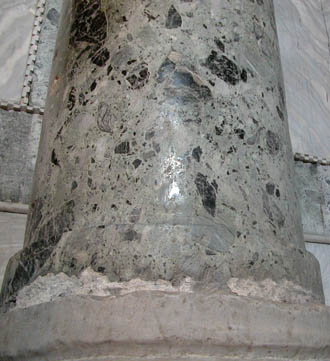
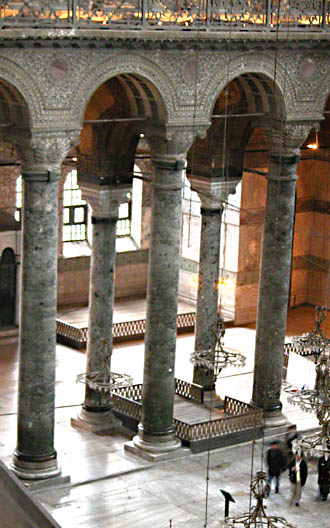
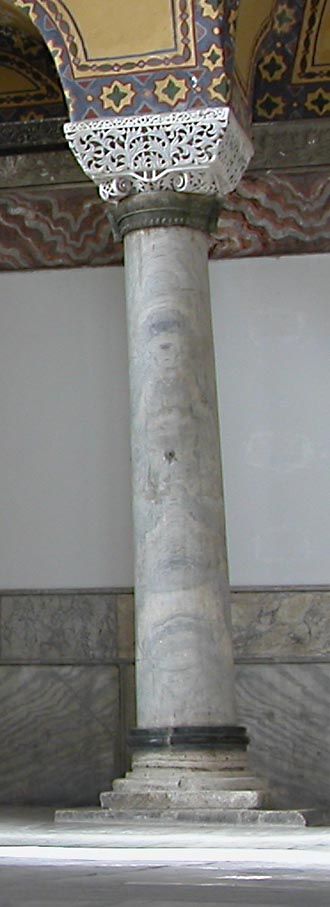 The column above is carved from Proconnesus marble. Below is a column made of Imperial porphyry from Gebel Dokhan in the Eastern desert of Egypt. The purple color in this extremely hard stone comes from hematite. Although the stone is very dense it can fracture under stress. Many of the porphyry columns in Hagia Sophia show visible cracks and have been reinforced with bronze collars.
The column above is carved from Proconnesus marble. Below is a column made of Imperial porphyry from Gebel Dokhan in the Eastern desert of Egypt. The purple color in this extremely hard stone comes from hematite. Although the stone is very dense it can fracture under stress. Many of the porphyry columns in Hagia Sophia show visible cracks and have been reinforced with bronze collars.
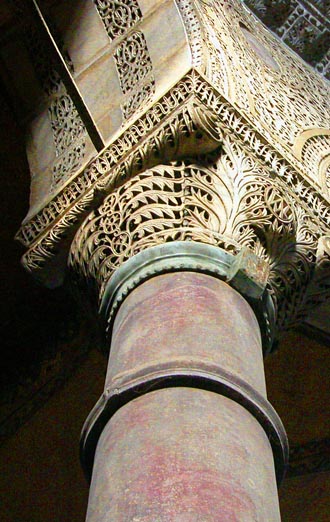
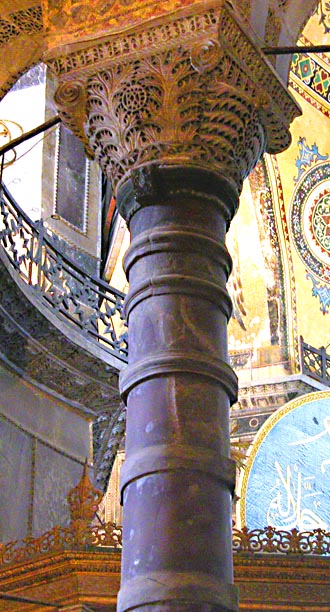

 The mosaics of the two archangels were huge - each one is around 30 feet tall - you can check out the image below from the 1930's for the scale. It is a great shame that we have lost almost all of Michael, but what we have of Gabriel is enough for us to understand the intention of the artists who made them in the 9th century. Thy were planned and designed by the clergy of Hagia Sophia, were ordered by the Patriarch and probably executed by church artists. This was after the end of iconoclasm, a period when religious images had been banned and destroyed by Byzantine emperors. There mosaics did not go up immediately after images had been restored, a few years were allowed to pass before they were ordered. There were two locations where the most important icons were raised up again one was Hagia Sophia and the other was the Chalke Gate of the Imperial Palace. There were two problems the church faced in redecorating Hagia Sophia with mosaic images; one nothing of that scale had been attempted in generations and two, there was a lack of experience artists and supplies. Millions of mosaic cubes were needed and the only immediate source was recycling old tesserae from older buildings. Many of these tesserae were damaged in salvaging them, getting chipped corners. Eventually Byzantium would be making tons of new mosaic, but that would be years after our mosaic was made. The only available mosaic artists had been making panels of mythology, charioteers, and secular scenes glorifying the emperor and his family. We don't know how far the visual arts had decayed by this time because almost nothing survives. Religious art still was being created, but on a small and secret scale,. The penalty for painting an icon was hand amputation, even death. Monumental religious art had been extinguished in the Byzantine Empire. Bringing it back from the dead would truly be a resurrection. Learning how to make big mosaics like these was a bit hit-or-miss. The artists learned project-by-project and established new traditions and methods that evolved into recognized workshops, which reached its zenith in the 12th century Deesis mosaic of Christ almost 300 years later.
The mosaics of the two archangels were huge - each one is around 30 feet tall - you can check out the image below from the 1930's for the scale. It is a great shame that we have lost almost all of Michael, but what we have of Gabriel is enough for us to understand the intention of the artists who made them in the 9th century. Thy were planned and designed by the clergy of Hagia Sophia, were ordered by the Patriarch and probably executed by church artists. This was after the end of iconoclasm, a period when religious images had been banned and destroyed by Byzantine emperors. There mosaics did not go up immediately after images had been restored, a few years were allowed to pass before they were ordered. There were two locations where the most important icons were raised up again one was Hagia Sophia and the other was the Chalke Gate of the Imperial Palace. There were two problems the church faced in redecorating Hagia Sophia with mosaic images; one nothing of that scale had been attempted in generations and two, there was a lack of experience artists and supplies. Millions of mosaic cubes were needed and the only immediate source was recycling old tesserae from older buildings. Many of these tesserae were damaged in salvaging them, getting chipped corners. Eventually Byzantium would be making tons of new mosaic, but that would be years after our mosaic was made. The only available mosaic artists had been making panels of mythology, charioteers, and secular scenes glorifying the emperor and his family. We don't know how far the visual arts had decayed by this time because almost nothing survives. Religious art still was being created, but on a small and secret scale,. The penalty for painting an icon was hand amputation, even death. Monumental religious art had been extinguished in the Byzantine Empire. Bringing it back from the dead would truly be a resurrection. Learning how to make big mosaics like these was a bit hit-or-miss. The artists learned project-by-project and established new traditions and methods that evolved into recognized workshops, which reached its zenith in the 12th century Deesis mosaic of Christ almost 300 years later.








 The Tunic
The Tunic

 Only tiny portions of this archangel remain, namely: four feathers of the right wing, part of the left foot, part of the ornamented hem of the tunic, the tip of the staff, the tip of one feather of the left wing, and, much higher up the arch, an insignificant fragment of the halo. The execution of these fragments is in all respects similar to that of the Archangel Gabriel. The buskin is in two shades of red, the lighted parts being in terracotta, the darker parts in red glass. The pearls on the toe of the buskin are in white limestone. The staff was in five vertical rows of gold, outlined with one row of red glass on the angel's right and three on the left. The tip of the staff, to a height of O.I9 m., was in silver, but the heads of most of the silver tesserae have flaked off, exposing clear glass. The feathers are in clear brown, pale turquoise, turquoise, dark blue, and black glass. The hem of the tunic is gold with a double, red line at the bottom and traces of a rinceau pattern, also in red.
Only tiny portions of this archangel remain, namely: four feathers of the right wing, part of the left foot, part of the ornamented hem of the tunic, the tip of the staff, the tip of one feather of the left wing, and, much higher up the arch, an insignificant fragment of the halo. The execution of these fragments is in all respects similar to that of the Archangel Gabriel. The buskin is in two shades of red, the lighted parts being in terracotta, the darker parts in red glass. The pearls on the toe of the buskin are in white limestone. The staff was in five vertical rows of gold, outlined with one row of red glass on the angel's right and three on the left. The tip of the staff, to a height of O.I9 m., was in silver, but the heads of most of the silver tesserae have flaked off, exposing clear glass. The feathers are in clear brown, pale turquoise, turquoise, dark blue, and black glass. The hem of the tunic is gold with a double, red line at the bottom and traces of a rinceau pattern, also in red.




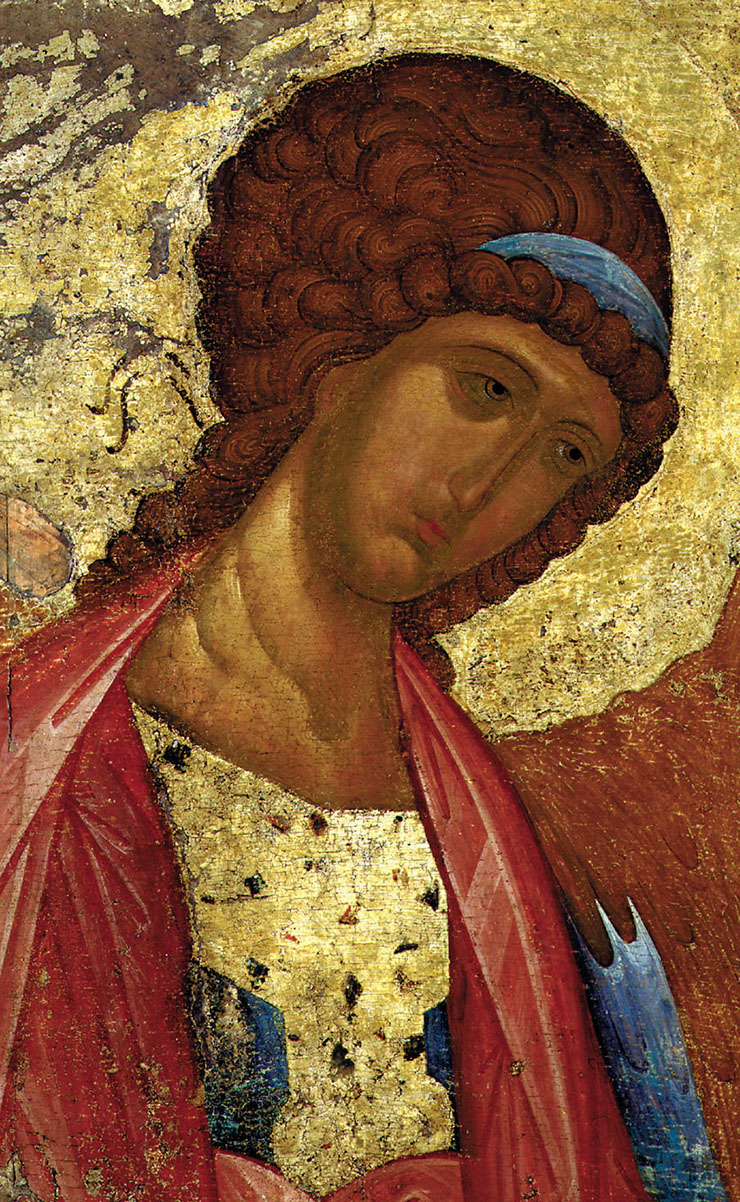
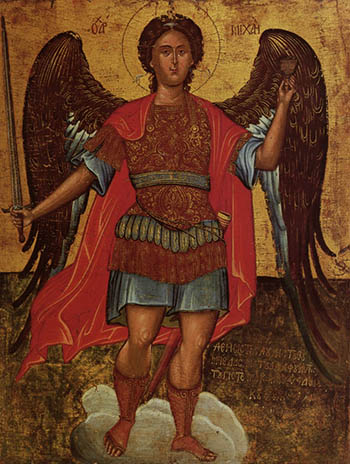
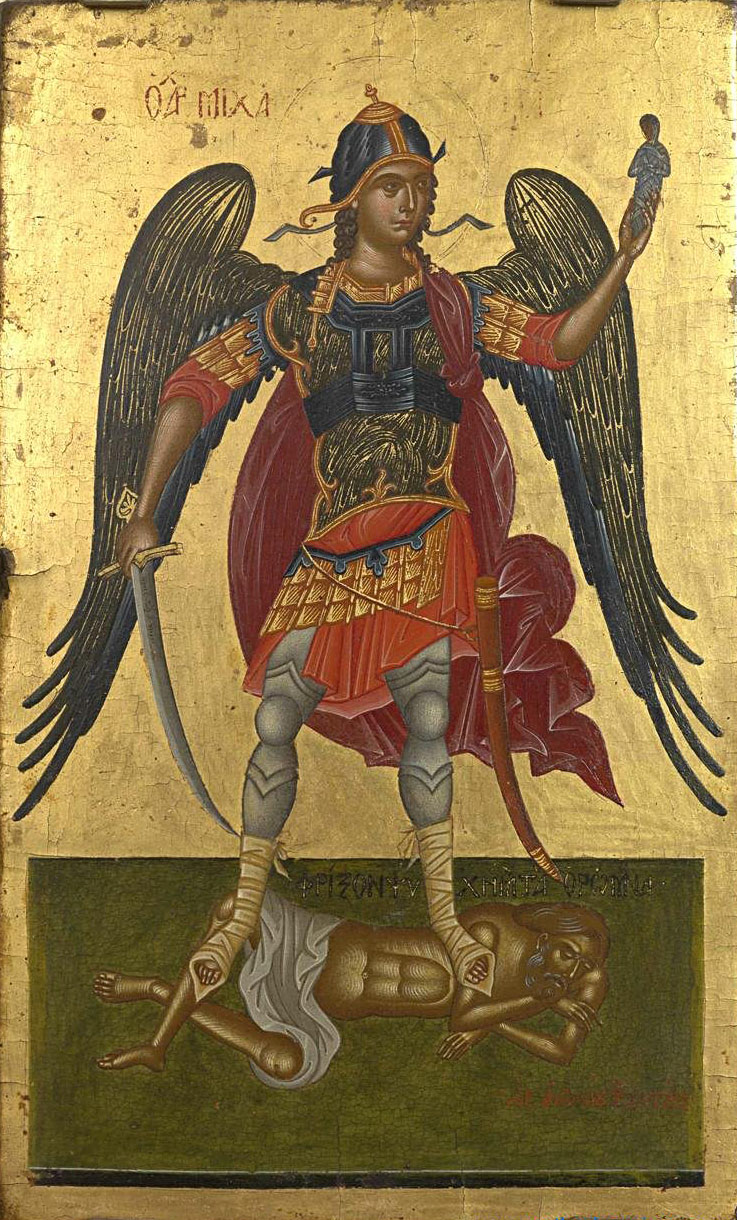
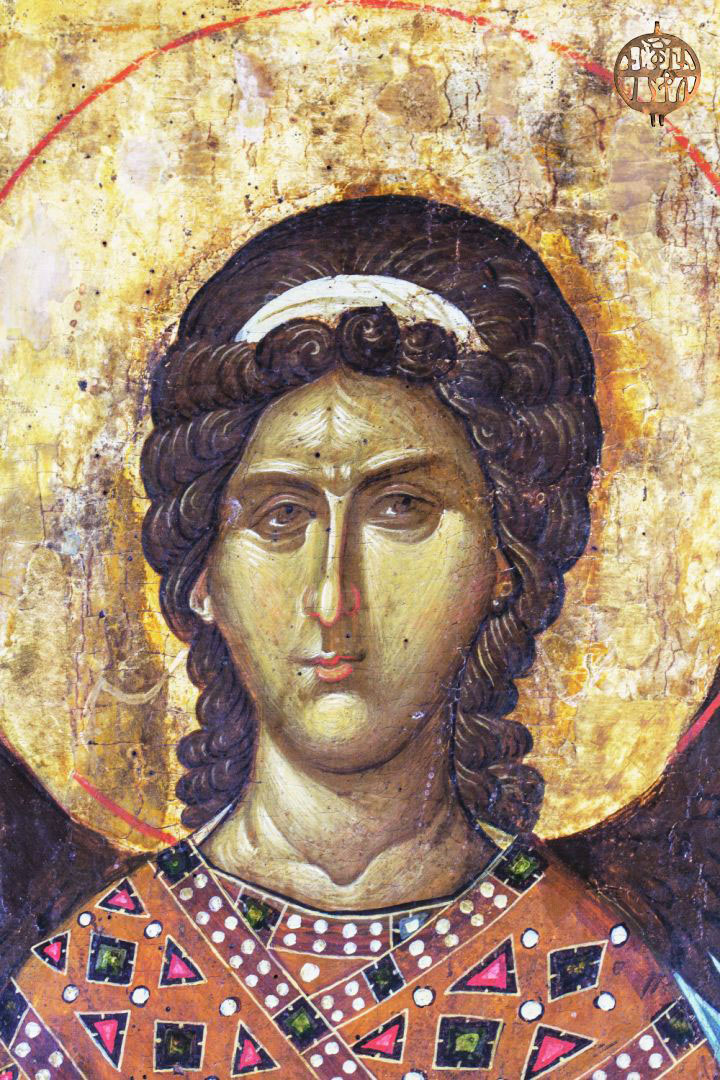
 click here for icons of christ
click here for icons of christ click here for icons of the theotokos
click here for icons of the theotokos click here for icons of angels
click here for icons of angels click here for icons of saints
click here for icons of saints








